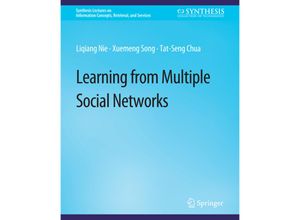With the proliferation of social network services more and more social users such as
individuals and organizations are simultaneously involved in multiple social networks for
various purposes. In fact multiple social networks characterize the same social users from
different perspectives and their contexts are usually consistent or complementary rather than
independent. Hence as compared to using information from a single social network appropriate
aggregation of multiple social networks offers us a better way to comprehensively understand
the given social users. Learning across multiple social networks brings opportunities to new
services and applications as well as new insights on user online behaviors yet it raises tough
challenges: (1) How can we map different social network accounts to the same social users? (2)
How can we complete the item-wise and block-wise missing data? (3) How can we leverage the
relatedness among sources to strengthen the learning performance? And (4) How can we jointly
model the dual-heterogeneities: multiple tasks exist for the given application and each task
has various features from multiple sources? These questions have been largely unexplored to
date. We noticed this timely opportunity and in this book we present some state-of-the-art
theories and novel practical applications on aggregation of multiple social networks. In
particular we first introduce multi-source dataset construction. We then introduce how to
effectively and efficiently complete the item-wise and block-wise missing data which are
caused by the inactive social users in some social networks. We next detail the proposed
multi-source mono-task learning model and its application in volunteerism tendency prediction.
As a counterpart we also present a mono-source multi-task learning model and apply it to user
interest inference. We seamlessly unify these models with the so-called multi-source multi-task
learning and demonstrate several application scenarios such as occupation prediction. Finally
we conclude the book and figure out the future research directions in multiple social network
learning including the privacy issues and source complementarity modeling. This is preliminary
research on learning from multiple social networks and we hope it can inspire more active
researchers to work on this exciting area. If we have seen further it is by standing on the
shoulders of giants.

